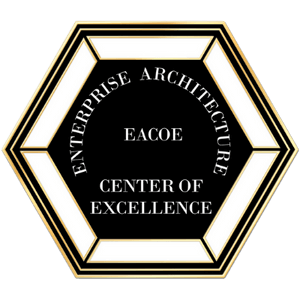The Enterprise Framework™ is the Definitive Framework for Your Architecture Activities - not just Enterprise Architecture.
The EACOE Enterprise Framework™ defines how to organize the structures and components within an architecture.
Business Leaders and Architects may use the framework to describe an organization's current, future, and gap analysis states.
To complement The Enterprise Framework™, the Enterprise Architecture Center Of Excellence (EACOE) Enterprise Architecture Methodology includes a standard set of skills, practices, definitions, templates, and tools for each step in the process of developing an Enterprise Architecture based on The Enterprise Framework™.
The Methodology demystifies the process of designing the architecture of the enterprise. It provides a step-by-step approach to Enterprise Architecture, ensuring the organization meets the goals and objectives established by management. The Methodology enables organizations to use Enterprise Architecture as a decision-making tool for business strategy, information technology development and alignment, risk analysis, and project and program prioritization.
There are many ways (methodologies) to use the Framework, but only a single, definite Framework should be used.
To make explicit representations easier to understand, the organization should work with a consistent set of diagrams and symbols that everyone understands.
It is important to realize that without these standardized representations, businesses are running off individualized, personal interpretations and networks.
Imagine what it would be like if every organization had its own version of the English alphabet—some with sixteen letters, some with twenty-six, and some with a hundred and forty-three!
Communication would be impossible. So it is without a Framework that is universal for Enterprise Architecture.
The major value of a blueprint, if it is constructed using a universally understood “language,” is that the same meaning is obtained no matter who is interpreting the blueprint. A blueprint’s value is severely limited if the author is the only person who can consistently interpret the representation. Using a Framework that everyone understands is imperative, and using a methodology in common for Enterprise Architecture provides organizational simplification.
The Enterprise Framework™
The Enterprise Framework™ defined
Based on the work of John Zachman and John Sowa from IBM and elaborations thereof, The EACOE’s Enterprise Framework™ leverages artifacts, diagrams, and abstractions widely recognized by business and technology professionals.
The first dimension of the Framework contains the six questions (abstractions or interrogatives) that have been used to investigate objects and events for thousands of years. Each interrogative serves a different purpose and is not interchangeable with the others. Each is unique and complete. These investigatory questions are also used in industries such as journalism, engineering, and construction.
For example, they are answered at the beginning of any well-written newspaper article. This standard way of exploring things is the first dimension of the Framework. The order of the columns is arbitrary since the questions do not need to be answered in any specific order. Once a specific order is applied to the Framework columns, a value proposition or methodology is introduced.
The second dimension of the Framework indicates the different transformations, and for the most part, possible perspectives, that exist in the enterprise. The transformations are not decompositions. The first row contains the enterprise scope: the goals, strategies, and tactics that describe the business.
The second row contains the Business Relationships among the objects in each column, and the third row contains the Technology Neutral View. The fourth row is “Technology Specific” (contains actual technologies), and the fifth row is a representation of solutions specific to each artifact. The last row represents the “Functioning Enterprise.” Unlike the columns, the rows have a specific order because they describe quality assurance and governance, ensuring alignment between the business of the enterprise and the information technology enablement of the business.
Each cell at the intersection of a row and column is enterprise-wide in scope, and detail, decomposition, and/or granularity occur within each cell in depth. For example, goals and strategies for the entire organization are contained in the cell at the intersection of Strategies and Goals and the Describe the Business row. The CEO’s goals are represented at the “highest” level, and then those goals are stratified into organizational and individual goals, as an example.
The Framework identifies everything that needs to be understood about an enterprise; it is the collection of all the perspectives/transformations that represent the functioning enterprise. At the same time, not all thirty architectural views are required before an enterprise gets started. As a matter of fact, most organizations’ architectures and strategies can initially be defined by only a handful of cells, as the methodology in this book will show; different types of artifacts will be used in different situations.
However, you need to understand that every perspective and transformation is important, and each exists whether or not it is explicitly represented- ed. Having explicit representations for each cell facilitates reuse and makes it possible to associate cells with each other: this is the ultimate in flexibility and agility, and may take some time to effect fully. The associations make it possible to identify gaps and overlaps. Just as not all of the letters of the alphabet are required to make a word or sentence, or not all of the elements in Mendeleev’s Periodic Table are required to make a chemical compound, not all of the cells are required for a given area of analysis in an Enterprise, initially. The Enterprise Framework, when used with an effective methodology, will produce a clear, verifiable, understandable, and effective business and technology strategy.
Practitioners have found The Enterprise Framework to be easy to explain and understand. The Enterprise Framework is human consumable.
Enterprise architecture, defined in terms of the framework, leads to the acknowledgment that there is more to an organization than mere data and functions. There are numerous other issues, multiple locations, and timing factors to consider while planning its development.
Do you want to enable the Zachman Framework and Enterprise Architecture?
We offer best-in-class Enterprise Architecture certification and training workshops by experienced practitioners to help you develop and produce Enterprise Architecture for your organization.

